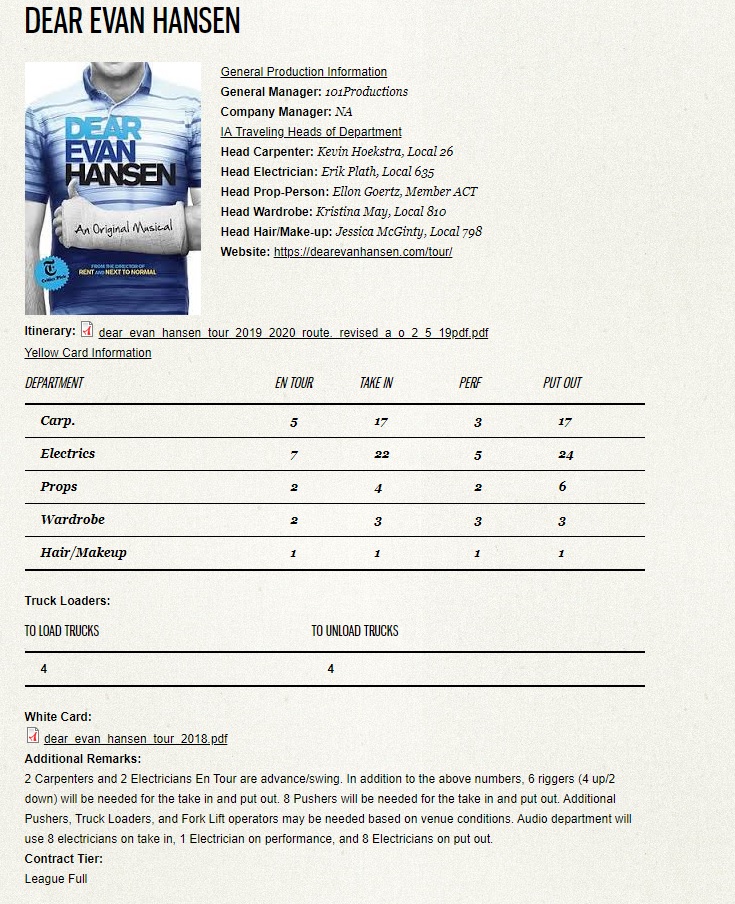Yellow Card Shows: What are they and what do those numbers mean?
Yellow Card Shows are, simply, shows that carry an all-IATSE crew and are a union tour. The first shows to travel under this arrangement were covered under District 1 (Northwest USA), and a bond was posted with the International to guarantee transportation home and two weeks’ pay for suddenly closed shows. The system was initially started so shows could send ahead the size and length of time local crews would be needed to assure there would be enough people to staff each theatre. It also helped ensure those were union crews, especially in venues that were not under an IA contract.
This system worked so well the International adopted it as an official policy a few years later, and the Yellow Card System is still in use today with very few changes to its original format. In today’s world, however, the Yellow Card does not ensure Local union workers; it only covers the road crew. When a show does play a union venue, a representative of the Local is supposed to check the show personnel’s travel cards to ensure they are travelling under proper documentation.
So what information does a Yellow Card contain?
It starts with general production information including who the General Manager and Company Managers are for the show. It also lists the IA traveling heads of department (Carpenter, Electrician, Props, Wardrobe, Hair/Makeup) and to which Locals they belong. You’ll also find the show’s website and an itinerary for the tour.
From there, you’ll see a list of departments, along with how many people the tour travels, and how many locals are required for Load In, Performance, and Load Out. Those numbers can change at the beginning of a tour as they determine how many people are actually needed, but the Yellow Card is supposed to be set after the show plays its third city on the tour. This can take more time than you’d think, as some shows sit in a city for several weeks or even months.
The departments listed are: Carpenters, Electrics, Props, Wardrobe, and Hair/Makeup. There is a separate section for Truck Loaders, both load in and load out. You may be thinking, “But what about audio, video, and riggers?” Audio and video are considered part of the electrics department, and riggers are considered part of the carpenters. There is a section for “Additional Remarks”, which is where the Head Carpenter on the tour will note how many of each are needed. This is also where extra positions such as pushers, fork lift operators, etc. will be listed, as well as anything they feel requires clarification.
Sometimes, but certainly not always, a show will also have a White Card filed with the International. The White Card contains information specifically for the wardrobe department, as often those positions require special skills and have work calls outside the normal load in, performance(s) and load out.
The last item on the Yellow Card is what tier contract the show is under with the International. That determines the conditions and minimum rates the road crew work under.
This is one that trips people up fairly often:
The Yellow Card contains the MINIMUM number of local workers a show requires in order to function. Local conditions always prevail. For example, if a Local’s contract requires non-working department heads, then the number of people in each department will increase by one. Or if a show does not call for an electrician for performances but the Local contract (as some of ours do) requires a department head if any equipment is used, then there will be an electrician for each performance. Usually the show’s head carpenter will include possible extra workers “based on venue conditions” or some wording to that effect.
All of the shows currently travelling under a Yellow Card with the International can be found on the IA’s website at https://www.iatse.net/member-resources/yellow-card-shows. The particular shows that are scheduled to stop at one of our venues can be found on the Local’s events calendar at https://www.iatse26.org/events/.


